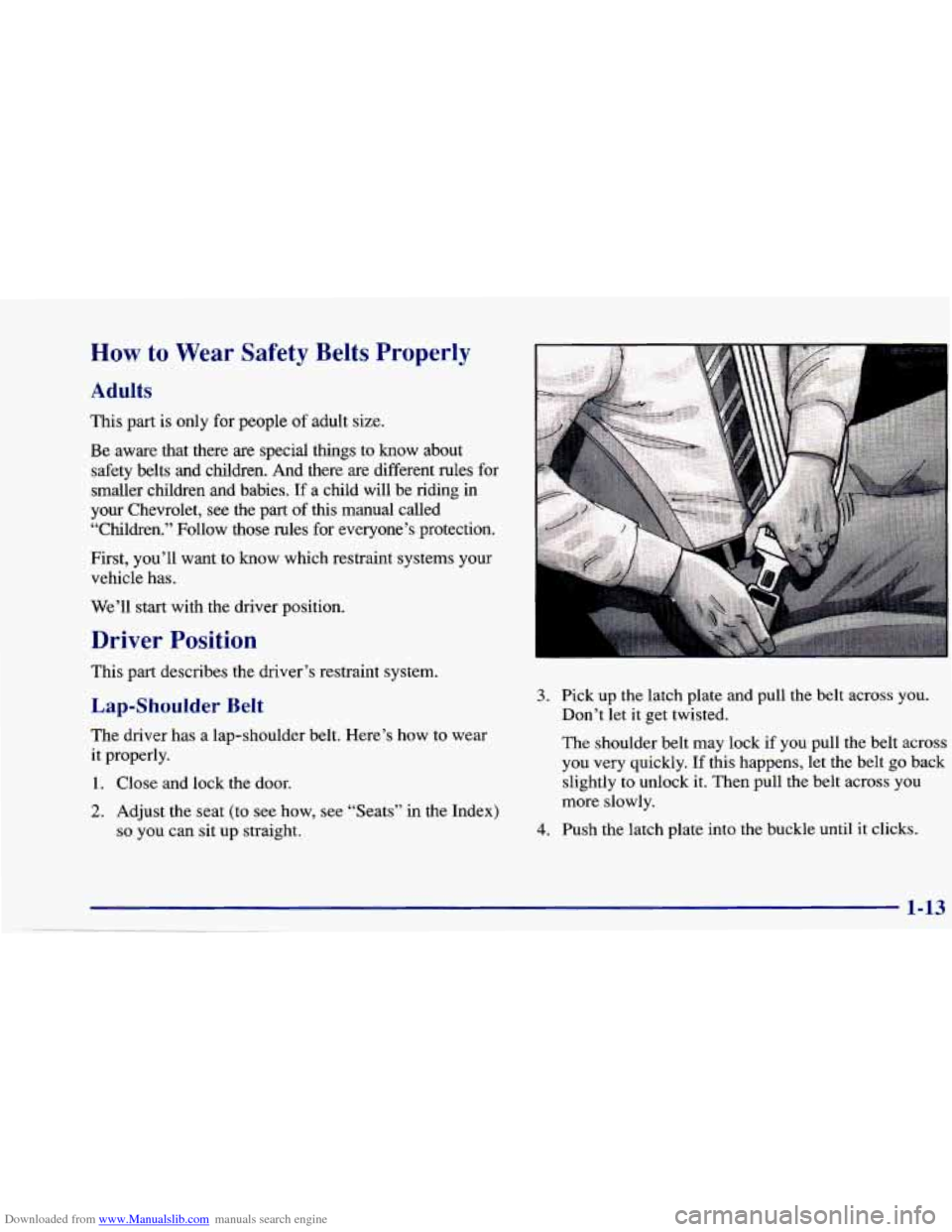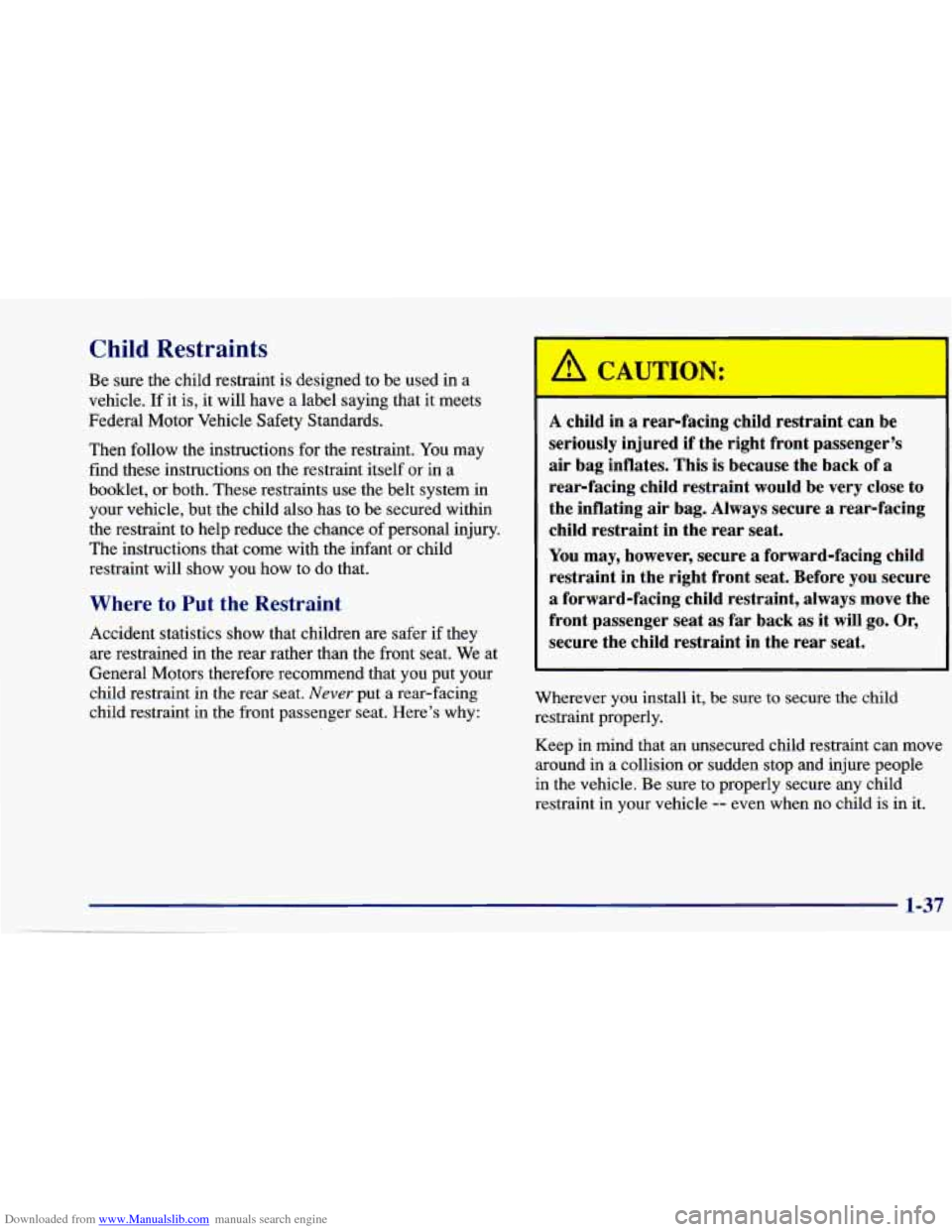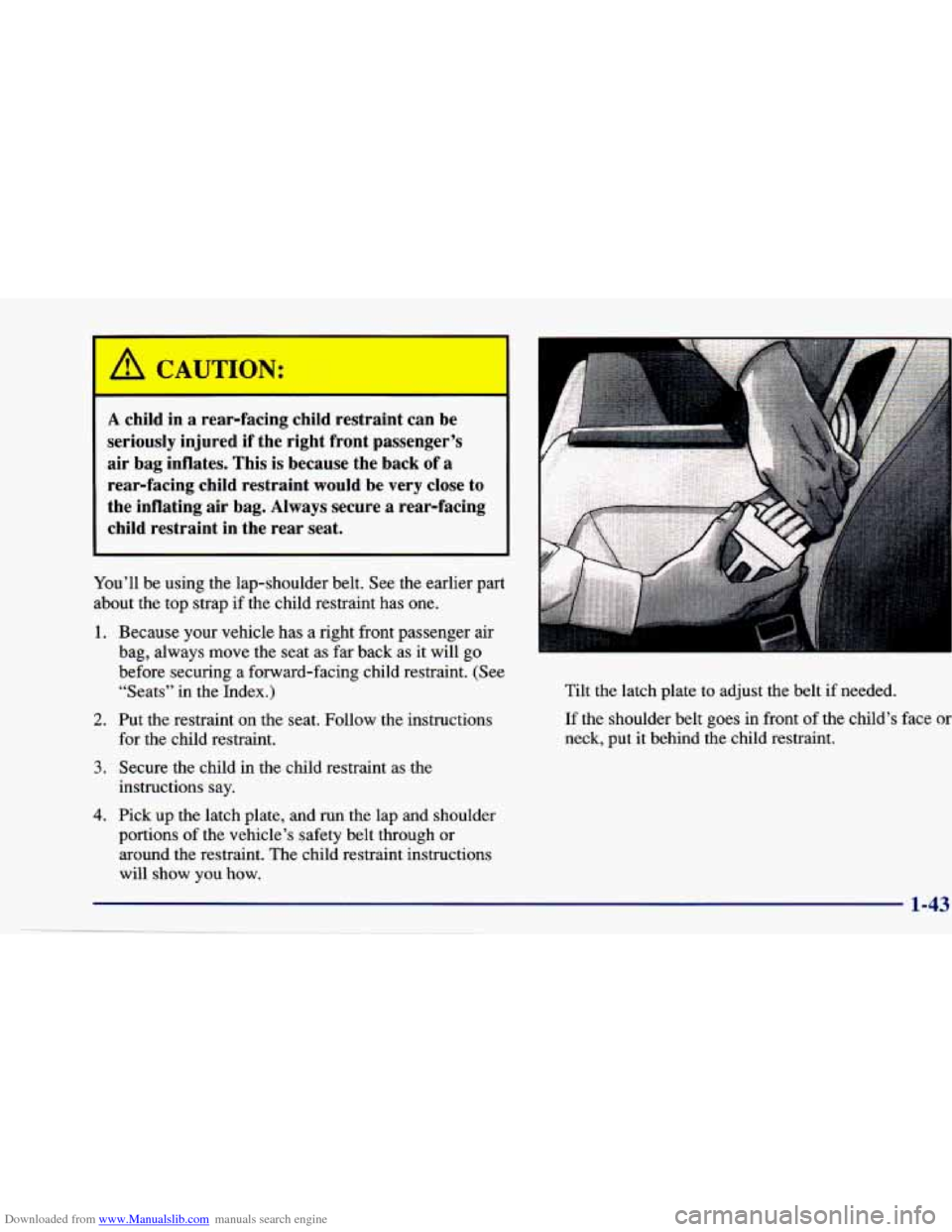Page 11 of 388
Downloaded from www.Manualslib.com manuals search engine Section 1 Seats and Restraint Systems
Here you’ll find information about the seats in your Chevrolet and how to use your safety belts properly. You can also
learn about some things you should nut do with air bags and safety belts.
1-2
1-7
1-12
1-13
1-13
1-21 1-22
1-22
1-28 Seats
and Seat Controls
Safety Belts: They’re for Everyone
Here Are Questions Many People Ask About
Safety Belts
-- and the Answers
How to Wear Safety Belts Properly
Driver Position
Safety Belt Use During Pregnancy
Right Front Passenger Position
Supplemental Restraint System (SRS)
Rear Seat Passengers 1-3 1
1-33 1-35
1-37
1-45
1-48
1-48 1-48 Rear Safety
Belt Comfort Guides for Children
and Small Adults
Center Passenger Position
Children
Child Restraints
Larger Children Safety Belt Extender
Checking Your Restraint Systems
Replacing Restraint System Parts After
a Crash
1-1
Page 23 of 388

Downloaded from www.Manualslib.com manuals search engine How to Wear Safety Belts Properly
Adults
This part is only for people of adult size.
Be aware that there
are special things to know about
safety belts and children. And there are different rules for
smaller children and babies.
If a child will be riding in
your Chevrolet, see the part
of this manual called
“Children.” Follow those rules for everyone’s protection,
First, you’ll want to know which restraint systems your
vehicle has.
We’ll start with the driver position.
Driver Position
This part describes the driver’s restraint system.
Lap-Shoulder Belt
The driver has a lap-shoulder belt. Here’s how to wear
it properly.
1. Close and lock the door.
2. Adjust the seat (to see how, see “Seats” in the Index)
so you can sit up straight.
3. Pick up the latch plate and pull the belt across you.
Don’t let it get twisted.
The shoulder belt may lock if
you pull the belt across
you very quickly. If this happens, let the belt go back
slightly to unlock it. Then pull the belt across you
more slowly.
4. Push the latch plate into the buckle until it clicks.
1-13
Page 47 of 388

Downloaded from www.Manualslib.com manuals search engine Child Restraints ’
A CAUTION:
A child in a rear-facing child restraint can be
seriously injured if the right front passenger’s
air bag inflates. This is because the back of
a
rear-facing child restraint would be very close to
the inflating air bag. Always secure
a rear-facing
child restraint in the rear seat.
You may, however, secure a forward-facing child
restraint in the right front seat. Before you secure
a forward-facing child restraint, always move the
front passenger seat
as far back as it will go. Or,
secure the child restraint in the rear seat.
Be sure the child restraint is designed to be used in a
vehicle.
If it is, it will have a label saying that it meets
Federal Motor Vehicle Safety Standards.
Then follow the instructions for the restraint. You may
find these instructions on the restraint itself or in a
booklet, or both. These restraints use the belt system in
your vehicle, but the child also has to be secured within
the restraint to help reduce the chance
of personal injury.
The instructions that come with the infant
or child
restraint will show you how to do that.
Where to Put the Restraint
Accident statistics show that children are safer if they
are restrained in the rear rather than the
front seat. We at
General Motors therefore recommend that you put your
child restraint
in the rear seat. Never put a rear-facing
child restraint in the front passenger seat. Here’s why: Wherever you install
it, be sure to secure the child
restraint properly.
Keep in mind that an unsecured child restraint
can move
around in a collision or sudden stop and injure people
in the vehicle. Be sure to properly secure any child
restraint in
your vehicle -- even when no child is in it.
1-37
Page 49 of 388
Downloaded from www.Manualslib.com manuals search engine Securing a Child Restraint in a Rear
Outside Seat Position
U
You’ll be using the lap-shoulder belt. See the earlier part
about the top strap
if the child restraint has one.
1. Put the restraint on the seat. Follow the instructions
for the child restraint.
2. Secure the child in the child restraint as the
instructions say.
3. Pick up the latch plate, and run the lap and shoulder
portions of the vehicle’s safety belt through or
around the restraint. The child restraint instructions
will show you how. Tilt the
latch plate to adjust the belt
if needed.
If the shoulder belt goes in front of the child’s face or
neck, put it behind the child restraint.
1-39
Page 51 of 388
Downloaded from www.Manualslib.com manuals search engine Securing a Child Restraint in the Center
Rear Seat Position
You’ll be using the lap belt.
See the
earlier part about the top strap if the child
restraint has one.
1. Make the belt as long as possible by tilting the latch
2. Put the restraint on the seat. Follow the instructions
plate and pulling
it along the belt.
for the child restraint.
3. Secure the child in the child restraint as the
instructions say.
4. Run the vehicle’s safety belt through or around the
restraint. The child restraint instructions will show
you how.
Page 52 of 388
Downloaded from www.Manualslib.com manuals search engine 5. Buckle the belt. Make sure the release button is
positioned
so you would be able to unbuckle the
safety belt quickly if you ever had to.
6. To tighten the belt, pull its free end while you push
down
on the child restraint.
7. Push and pull the child restraint in different
directions to be sure it is secure.
If it isn’t, secure the
restraint in a different place in the vehicle and
contact the child restraint maker for their advice
about how to attach the child restraint properly.
To remove the child restraint, just unbuckle the vehicle’s
safety belt. It will be ready to
work for an adult or larger
child passenger.
Securing a Child Restraint in the Right
Front Seat Position
U
Your vehicle has a right front passenger air bag. Never
put a rear-facing child restraint in this seat. Here’s why:
Page 53 of 388

Downloaded from www.Manualslib.com manuals search engine A child in a rear-facing child restraint can be
seriously injured if the right front passenger’s
air bag inflates. This is because the back of
a
rear-facing child restraint would be very close to
the inflating air bag. Always secure a rear-facing
child restraint
in the rear seat.
You’ll be using the lap-shoulder belt. See the earlier part
about the top strap if the child restraint has one.
1. Because your vehicle has a right front passenger air
bag, always move the seat
as far back as it will go
before securing a fonvard-facing child restraint. (See
“Seats” in the Index.)
2. Put the restraint on the seat. Follow the instructions
for the child restraint. Tilt the
latch plate to adjust the belt if needed.
If the shoulder belt goes in front of the child’s face or
neck, put it behind the child restraint.
3. Secure the child in the child restraint as the
instructions say.
4. Pick up the latch plate, and run the lap and shoulder
portions
of the vehicle’s safety belt through or
around the restraint. The child restraint instructions
will show you
how.
Page 55 of 388
Downloaded from www.Manualslib.com manuals search engine Larger Children
Children who have outgrown child restraints should
wear the vehicle’s safety belts.
If you have the choice, a child should sit next to a
window
so the child can wear a lap-shoulder belt and
get the additional restraint a shoulder belt can provide.
Accident statistics show that children are safer
if they
are restrained
in the rear seat. But they need to use the
safety belts properly.
Children who aren’t buckled up can be thrown out in
a crash.
0 Children who aren’t buckled up can strike other
people who are.
1-45